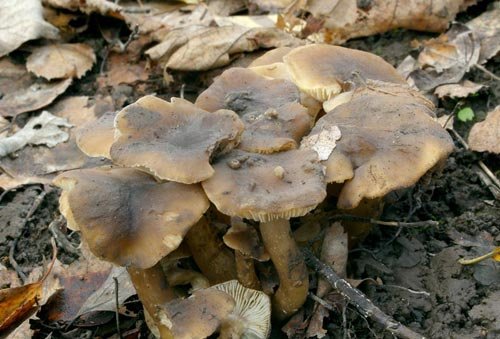Crowded Row (Lyophyllum decastes)
- Division: Basidiomycota (Basidiomycetes)
- Subdivision: Agaricomycotina (Agaricomycetes)
- Class: Agaricomycetes (Agaricomycetes)
- Subclass: Agaricomycetidae (Agaricomycetes)
- Order: Agaricales (Agaric or Lamellar)
- Family: Lyophyllaceae (Lyophyllic)
- Genus: Lyophyllum (Lyophyllum)
- Type: Lyophyllum decastes (Crowded rowweed)
- Lyophyllum crowded
- Row group

Lyophyllum crowded is very widespread. Until recently, it was believed that the main “patrimony” of this fungus is parks, squares, roadsides, slopes, edges and similar open and semi-open places. At the same time, there was a separate species, Lyophyllum fumosum (L. smoky gray), associated with forests, especially conifers, some sources even described it as a mycorrhiza former with pine or spruce, outwardly very similar to L.decastes and L.shimeji. Recent studies at the molecular level have shown that no such single species exists, and all finds classified as L.fumosum are either L.decastes (more common) or L.shimeji (Lyophyllum shimeji) (less common, in pine forests). Thus, as of today (2018), the species L.fumosum has been abolished, and is considered a synonym for L.decastes, significantly expanding the latter’s habitats, almost to “anywhere”. Well, L.shimeji, as it turned out, grows not only in Japan and the Far East, but is widely distributed throughout the boreal zone from Scandinavia to Japan, and, in some places, is found in pine forests of the temperate climate zone. It differs from L. decastes only in larger fruiting bodies with thicker legs, growth in small aggregates or separately, attachment to dry pine forests, and, well, at the molecular level.
Hat:
A crowded row has a large hat, 4-10 cm in diameter, in youth hemispherical, cushion-shaped, as the mushroom matures, it opens to a half-spread, less often prostrate, often losing its geometric correctness of shape (the edge wraps up, becomes wavy, cracks, etc. ). In one joint, you can usually find hats of different sizes and shapes. The color is gray-brown, the surface is smooth, often with adhering earth. The flesh of the cap is thick, white, dense, elastic, with a slight “row” smell.
Records:
Relatively dense, white, slightly adherent or loose.
Spore powder:
White.
Leg:
Thickness 0,5-1,5 cm, height 5-10 cm, cylindrical, often with a thickened lower part, often twisted, deformed, fused at the base with other legs. Color – from white to brownish (especially in the lower part), the surface is smooth, the pulp is fibrous, very durable.
late mushroom; occurs from late August to late October in forests of various types, preferring specific areas such as forest roads, thinned forest edges; sometimes comes across in parks, meadows, in forbs. In most cases, it bears fruit in large clusters.
The fused row (Lyophyllum connatum) has a light color.
Crowded row can be confused with some edible and inedible agaric species that grow in clumps. Among them are such species of the ordinary family as Collybia acervata (a smaller mushroom with a reddish tinge of the cap and legs), and Hypsizygus tessulatus, which causes brown rot of wood, as well as some species of honey agarics from the genus Armillariella and meadow honey agaric (Marasmius oreades).
Crowded rowweed is considered a low-quality edible mushroom; the texture of the pulp gives an exhaustive answer why.









